Creep Simulation and Validation for a Finite Element Analysis of Expanded Polystyrene-Based Cushioning Systems
Abstract
:1. Introduction
2. Experimental Design and FE Modeling
2.1. Experimental Materials
2.2. Experimental Apparatus and Methods
2.3. FE Modeling and Analysis Procedures
3. Results and Discussion
3.1. Mechanical Properties of EPS
3.2. Nonlinear Creep Behavior Modeling of EPS
3.3. Validation of the EPS Material Properties for 7-Day-Long Creep Behavior Tests
4. Conclusions
- The EPS elastic modulus and Poisson’s ratio were analyzed as its elastic properties. Because the proportional limit and 10% strain strength of EPS did not exhibit temperature trends for temperatures in the 0–60 °C range, the elastic modulus and Poisson’s ratio were analyzed only for density dependence. Both mechanical properties were significantly affected by the EPS density and increased with increasing density. Compared with the initial tangent modulus (Young’s modulus) of the initial proportional portion, the secant modulus was approximately 35–38%, and the tangent modulus was approximately 5–9%. With increasing density, the EPS Poisson’s ratio increased almost linearly, and it was approximately 0.095–0.175 for densities in the 16–30 kg/m3 range.
- After describing the measured 12-h-long creep data using the Burgers model, the characteristics were qualitatively analyzed using the model’s constant values. The instantaneous elastic strain, creep amount, and rate of the transient and steady-state creep phases increased with increasing applied stress. In addition, along with these values, the retardation time significantly differed, depending on whether the applied stress was below or above the proportional limit. However, the effect of density on these properties could not be analyzed because the applied stress levels were different for different densities.
- As a result of performing two-step FEA on the EPS creep behavior using the measured elastic modulus, Poisson’s ratio, and 7-day-long creep data, the concordance between the experimental and FEA results was 89.5–95.2% for step 1 and 88.4–97.7% for step 2; the overall concordance was very high, in the 90.3–100% range.
- The values of the elastic and viscoelastic properties measured in this study were captured well by FEA. Therefore, by applying the validation results for creep behavior to the material properties in FEA, it is believed that the reliability of the FEA prediction for the inclination amount of unitized loads owing to the displacement of EPS-based cushioning systems in multiple stages of actual packaged appliances can be improved.
Author Contributions
Funding
Institutional Review Board Statement
Informed Consent Statement
Data Availability Statement
Conflicts of Interest
References
- Park, J.M.; Han, J.G. Transport Packaging Design Engineering; Munundang: Seoul, Republic of Korea, 2011. [Google Scholar]
- Available online: https://polymerdatabase.com/polymer%20physics/Linear%20Viscoelasticity.html (accessed on 5 July 2022).
- Lim, S.D.; Rhee, J.M.; Nah, C.; Lee, S.H.; Lyu, M.Y. Predicting the long-term creep behavior of plastics using the short-term creep test. Intern. Polym. Process. 2004, 19, 313–318. [Google Scholar] [CrossRef]
- Penny, R.K. Design for Creep; McGraw-Hill: New York, NY, USA, 1971. [Google Scholar]
- Crawford, R.J. Plastics Engineering; Pergamon: New York, NY, USA, 1989. [Google Scholar]
- Carriere, C.J.; Bank, D.; Malanga, M. Evaluation and modeling of the high-temperature short-term creep performance of selected glass-filled semicrystalline and liquid crystalline polymers. J. Appl. Polym. Sci. 1998, 67, 1177–1183. [Google Scholar] [CrossRef]
- Deng, M.; Latour, R.A.; Ogale, A.A.; Shalaby, S.W. Study of creep behavior of ultra-high-molecular- weight polyethylene systems. J. Biomed. Mater. Res. 1998, 40, 214–223. [Google Scholar] [CrossRef]
- Akinay, A.E.; Brostow, W.; Maksimov, R. Prediction of long-term service performance of polymeric materials from short-term tests: Creep and prediction of the stress shift factor of a longitudinal polymer liquid crystal. Polym. Eng. Sci. 2001, 41, 977–981. [Google Scholar] [CrossRef]
- Gnip, I.Y.; Vaitkus, S.; Keršulis, V.; Vėjelis, S. Experiments for the long-term prediction of creep strain of expanded polystyrene under compressive stress. Polym. Test. 2010, 29, 693–700. [Google Scholar] [CrossRef]
- Gnip, I.Y.; Vaitkus, S.; Keršulis, V.; Vėjelis, S. Analytical description of the creep of expanded polystyrene (EPS) under long-term compressive loading. Polym. Test. 2010, 30, 493–500. [Google Scholar] [CrossRef]
- Sudduth, R.D. Development of a simplified relationship between uniaxial creep, stress relaxation, and constant strain-rate results for viscoelastic polymeric materials. J. Appl. Polym. Sci. 2001, 82, 527–540. [Google Scholar] [CrossRef]
- Dropic, M.J.; David, H.; Johnson, P.E.; David, E.; David, P.E. Developing an ANSYS creep model for polypropylene from experimental data. In Proceedings of the International ANSYS Conference, Canonsburg, PA, USA, 22–24 April 2002; Volume 161. [Google Scholar]
- ISO 844; Rigid Cellular Plastics—Determination of Compression Properties. ISO: Geneva, Switzerland, 2014.
- Awol, T. A Parametric Study of Creep on EPS Geofoam Embankments; Department of Civil and Transport Engineering, Norwegian University of Science and Technology: Trondheim, Norway, 2012. [Google Scholar]
- EPS Civil Engineering Method Development Organization. EPS Method; Science and Technology Book Co., Ltd.: Tokyo, Japan, 1993. [Google Scholar]
- Jung, C.H. Long-Term Behavior of the Soft Ground Improved by EPS. Ph.D. Thesis, Han-Yang University, Seoul, Republic of Korea, 2008. [Google Scholar]
- Marcondes, J.; Hatton, K.; Graham, J.; Schueneman, H. Effect of temperature on the cushioning properties of some foamed plastic materials. Packag. Technol. Sci. 2003, 16, 69–76. [Google Scholar] [CrossRef]
- Elragi, A.; Negussey, D.; Kyanka, G. Sample size effect on the behavior of EPS geofoam. In Proceedings of the Soft Ground Technology Conference, Noordwijkerhout, The Netherlands, 28 May–2 June 2001. [Google Scholar]
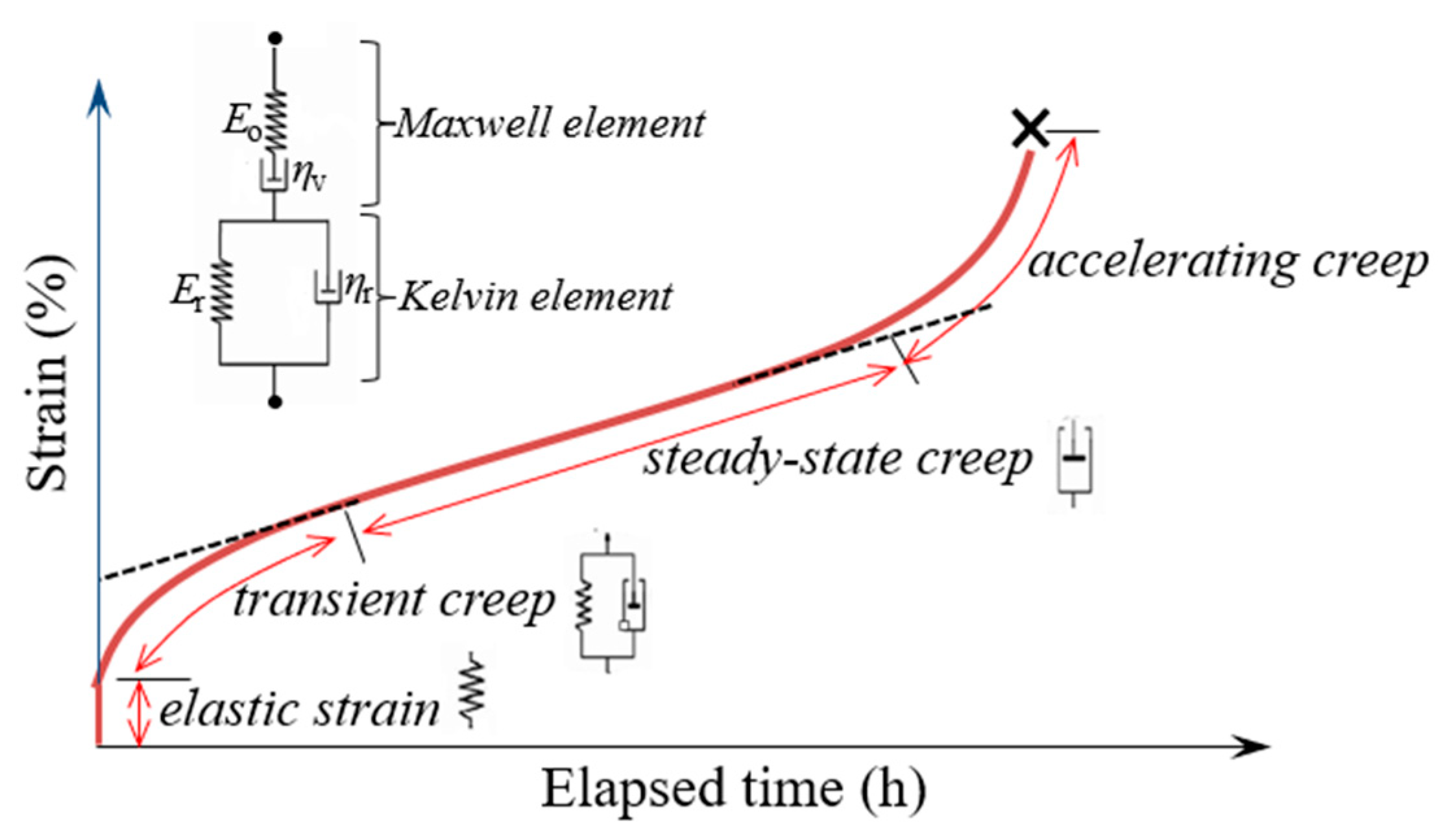

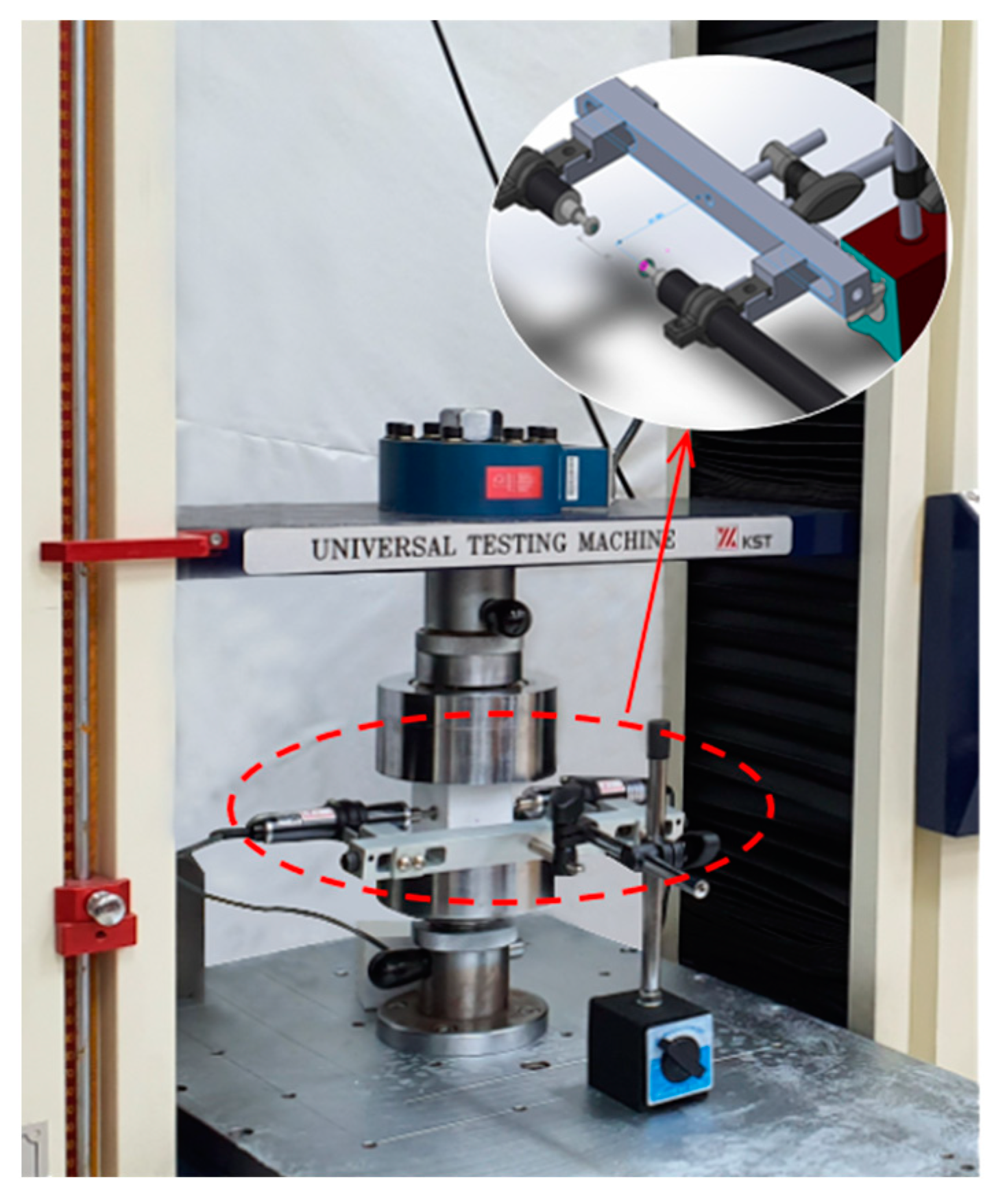

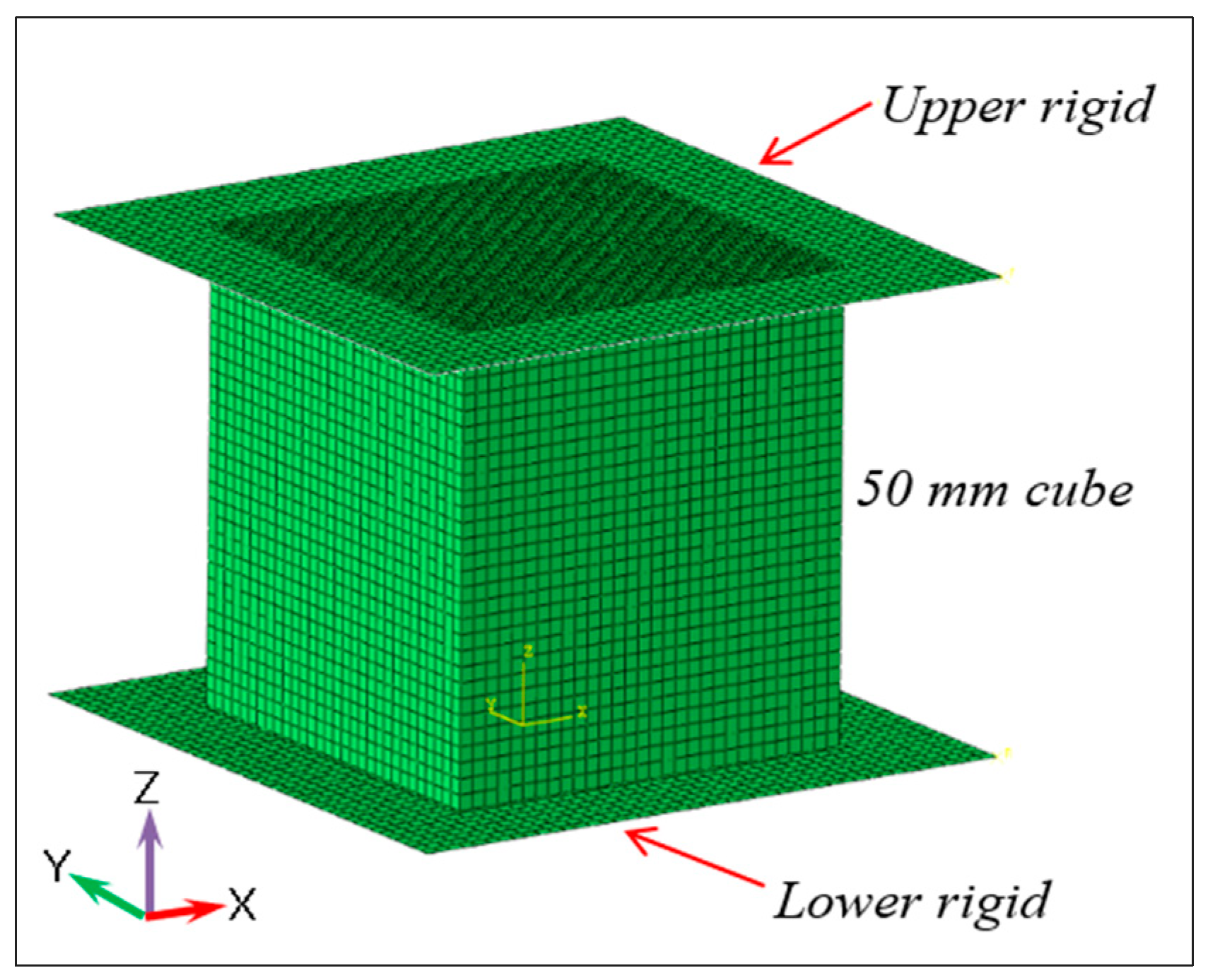

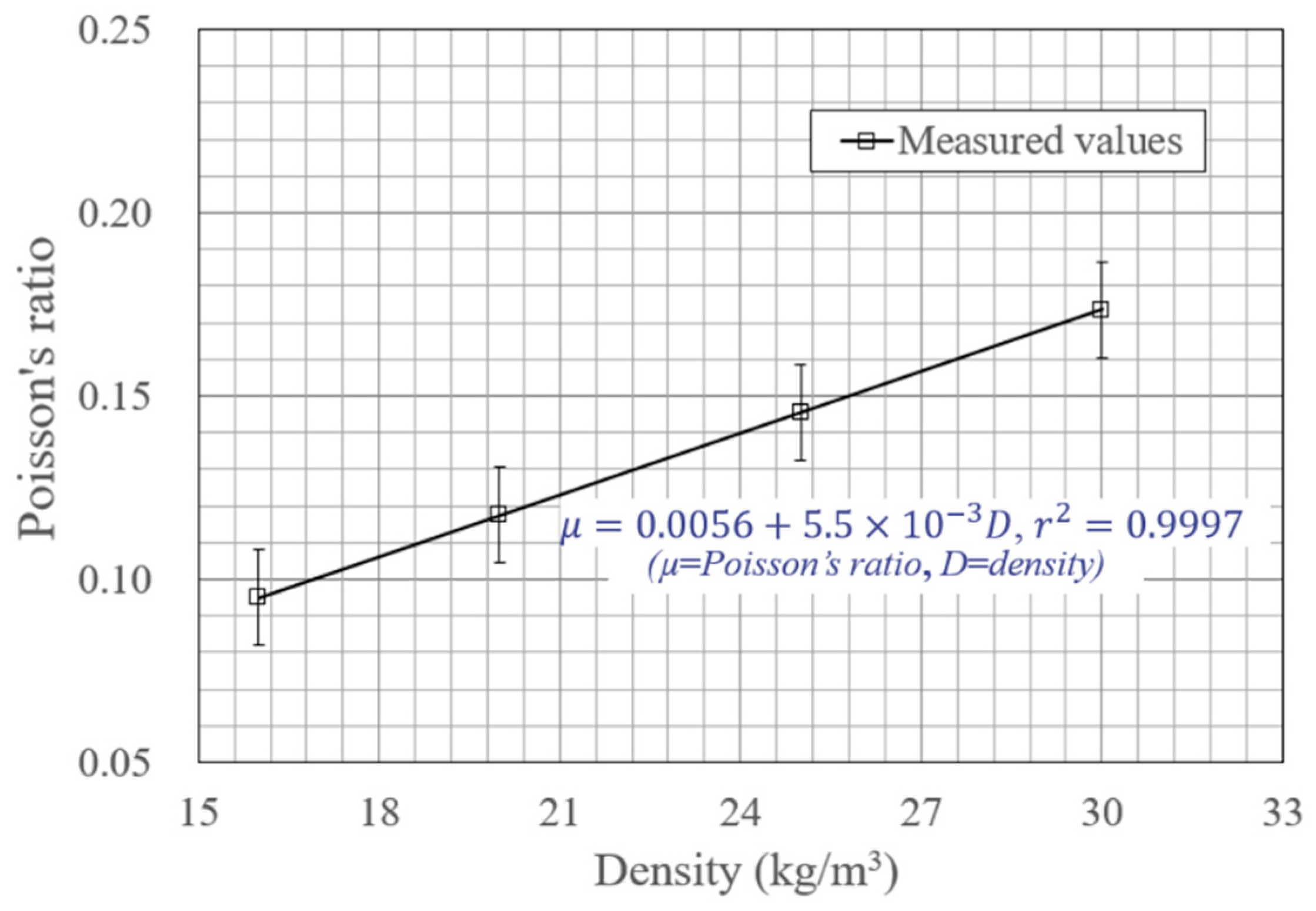
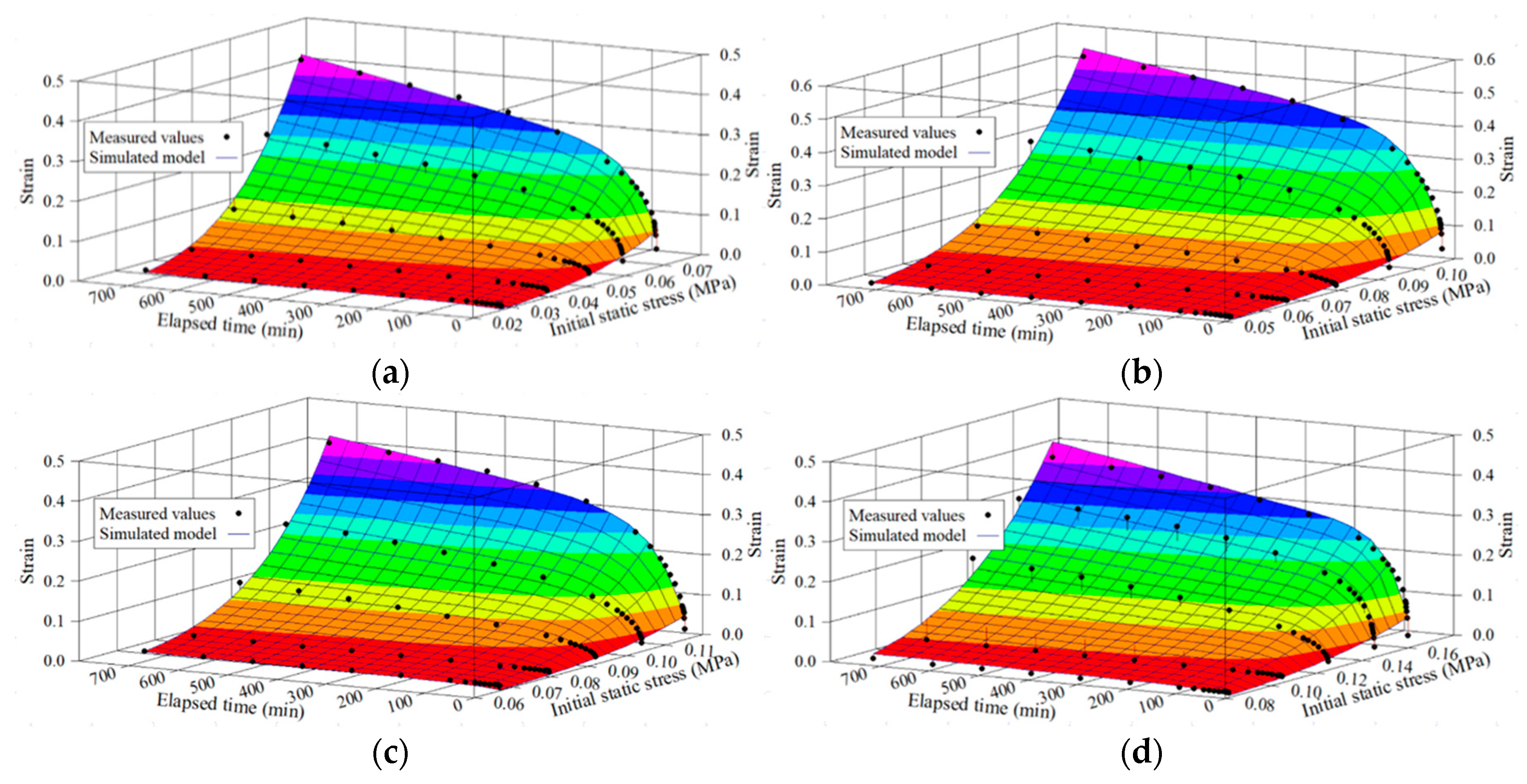
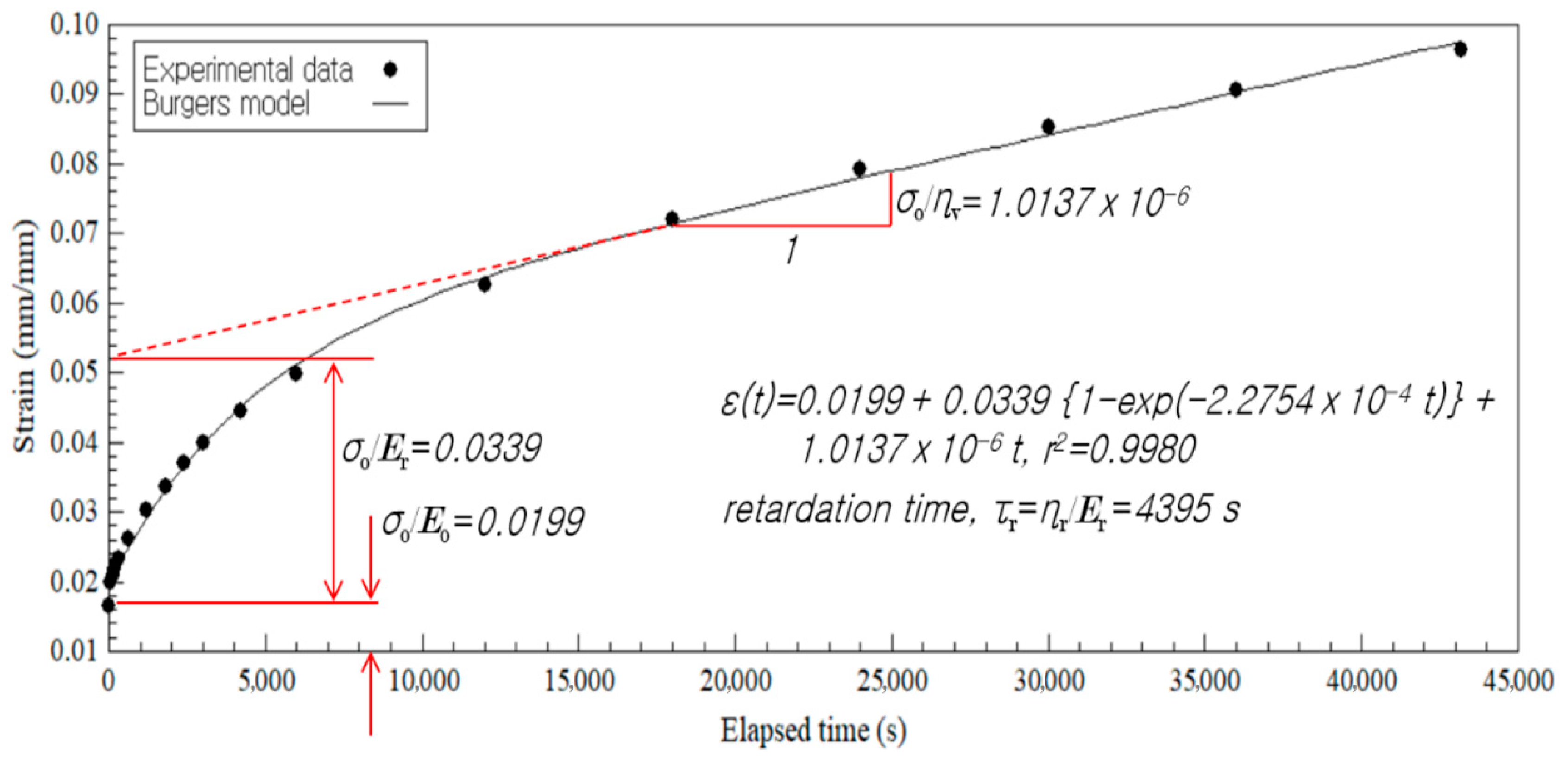
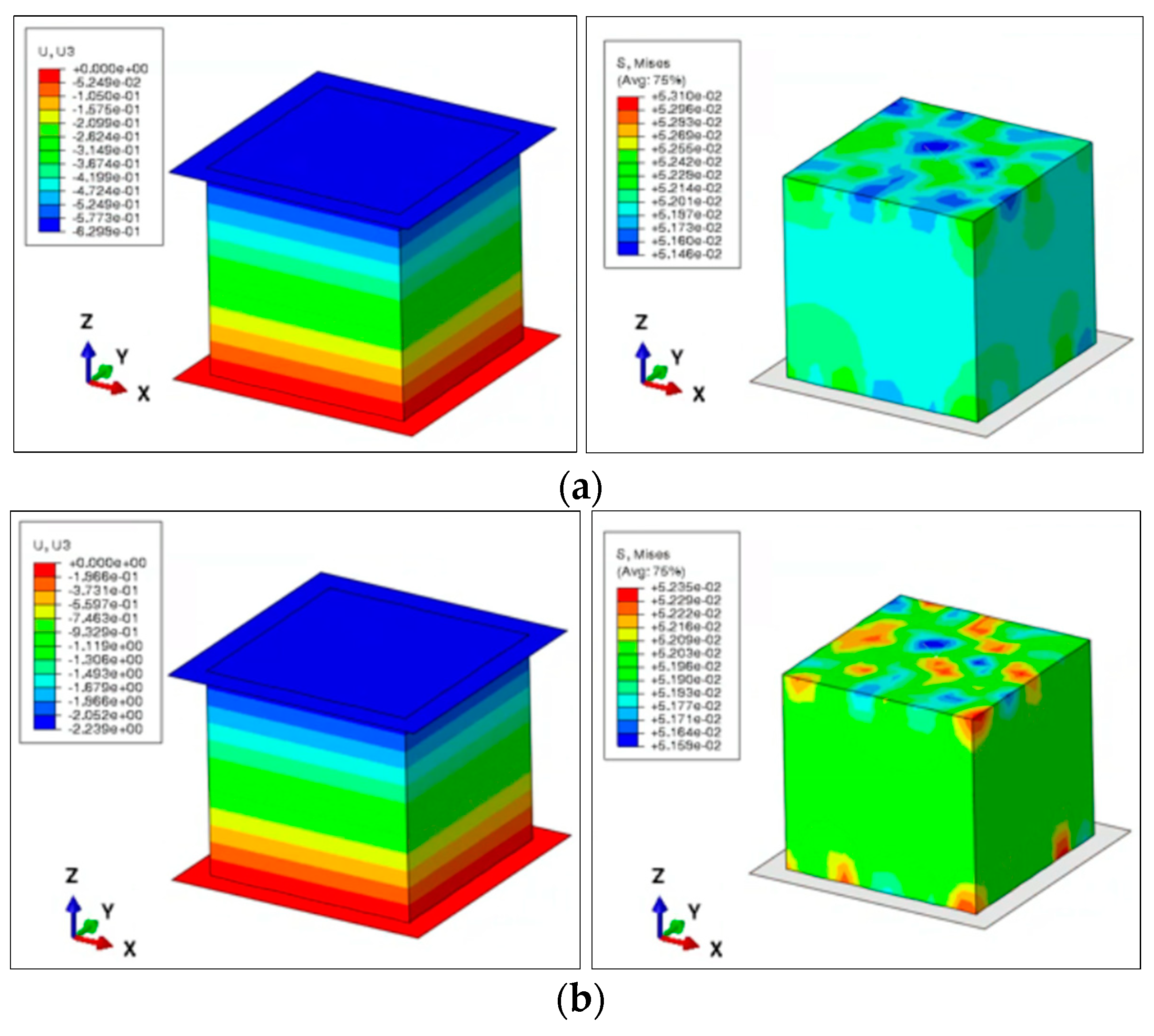
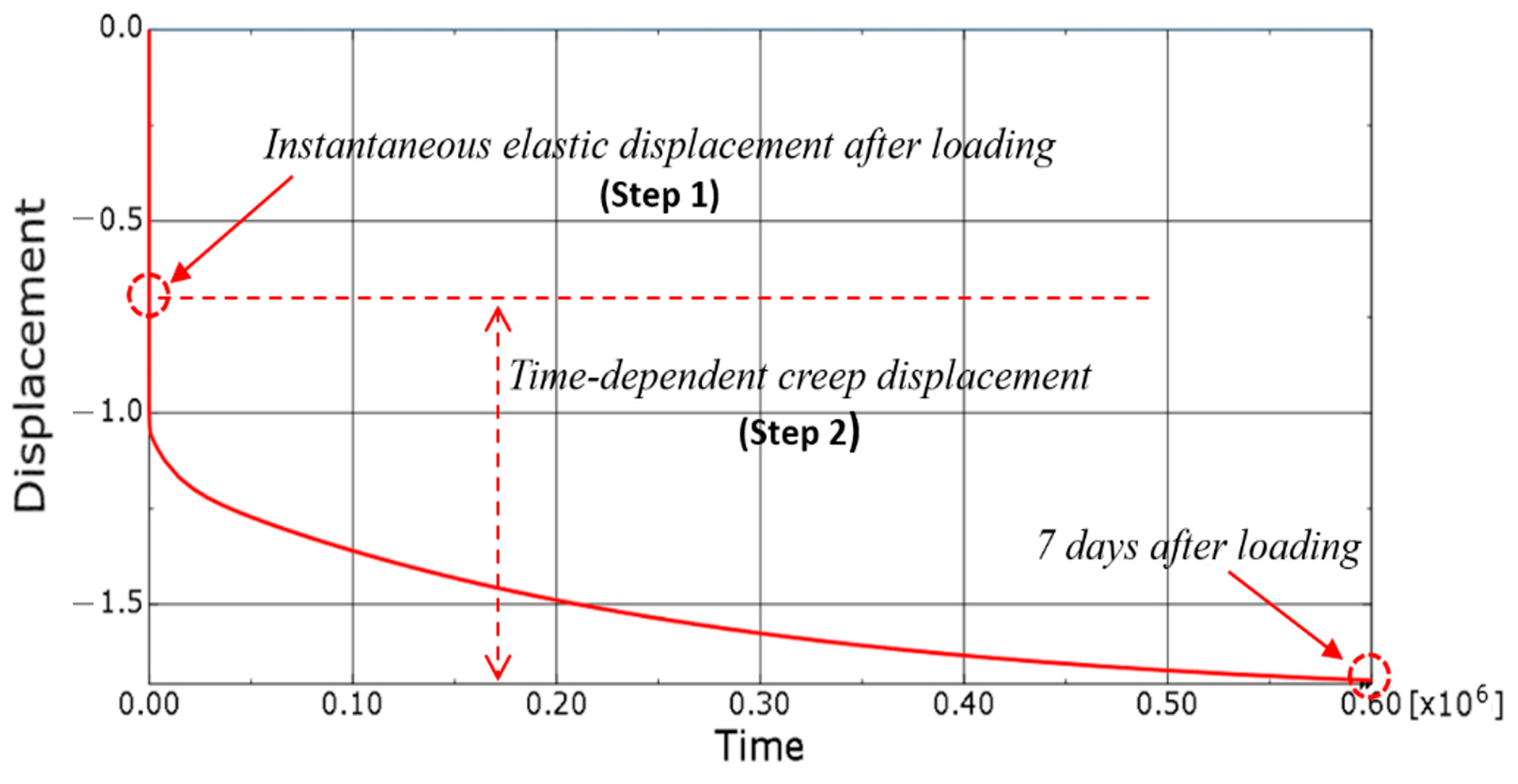
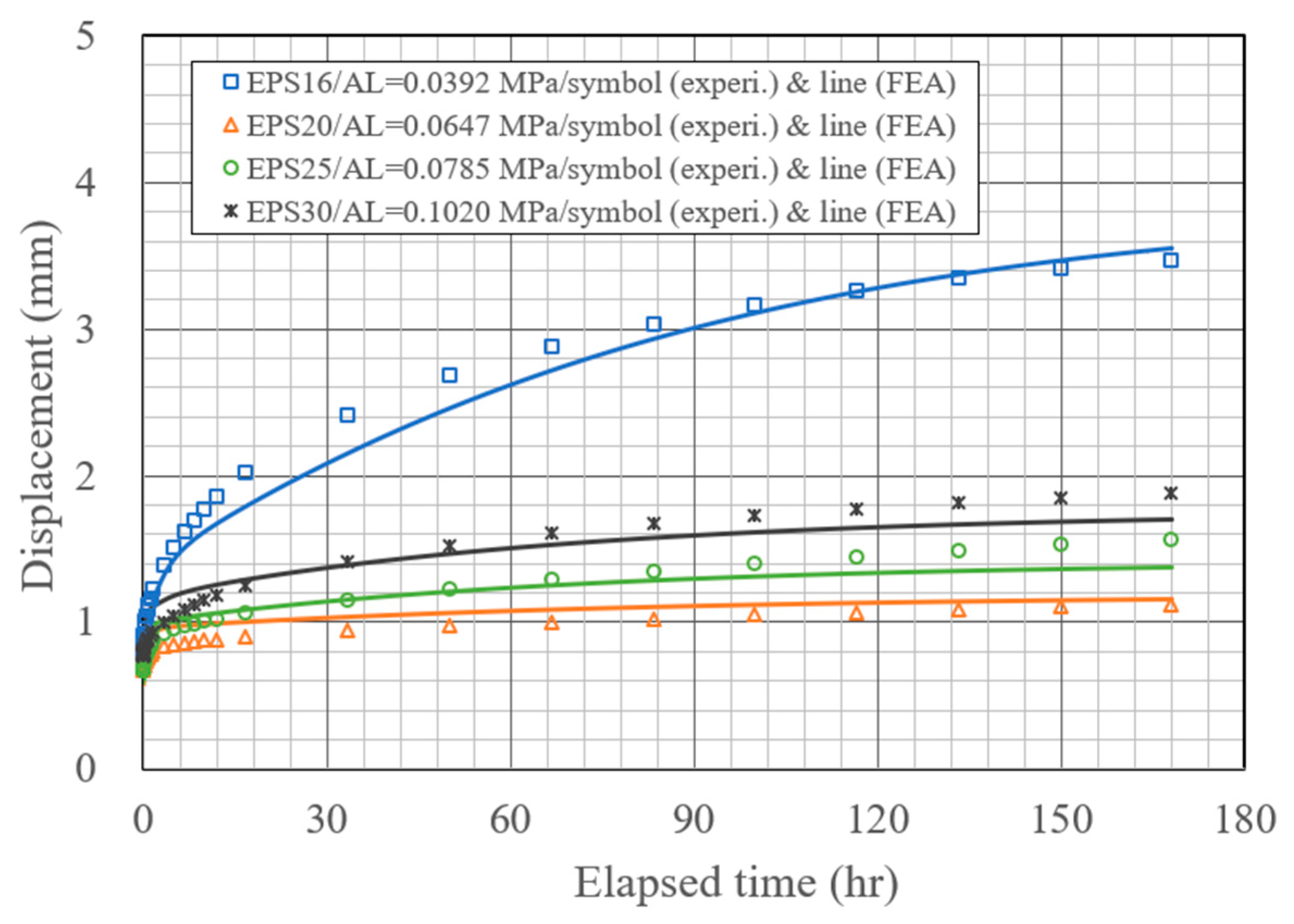
| Density (kg/m3) | Proportional Limit (kPa) | 10% Strain Strength (kPa) | ||||||||
|---|---|---|---|---|---|---|---|---|---|---|
| 0 °C | 20 °C | 40 °C | 60 °C | Ave. | 0 °C | 20 °C | 40 °C | 60 °C | Ave. | |
| 16 | 45.17 (±2.25) aa | 38.00 (±0.71) aa | 45.17 (±2.25) aa | 40.83 (±1.18) aa | 42.29 (±3.50) a | 94.45 (±2.64) aa | 82.49 (±2.29) aa | 79.64 (±1.94) ba | 77.15 (±1.12) ba | 83.97 (±6.99) a |
| 20 | 75.00 (±4.08) ab | 74.00 (±3.26) ab | 68.50 (±6.79) ab | 69.17 (±3.12) ab | 71.67 (±5.39) b | 131.46 (±3.30) ab | 125.80 (±5.81) ab | 125.69 (±6.44) ab | 121.98 (±2.08) ab | 126.23 (±5.84) b |
| 25 | 77.50 (±6.12) ab | 85.50 (±2.68) ab | 79.00 (±4.32) bb | 81.67 (±3.12) bb | 80.92 (±5.24) c | 155.92 (±5.45) ac | 153.38 (±3.92) ac | 143,12 (±4.92) bb | 143.46 (±3.71) bc | 149.50 (±7.29) c |
| 30 | 133.33 (±4.71) ac | 121.67 (±9.20) ac | 126.67 (±4.71) ac | 118.33 (±2.36) ac | 125.00 (±8.10) d | 201.12 (±6.17) ad | 190.82 (±6.27) ad | 187.41 (±3.37) ab | 191.39 (±2.72) ad | 192.69 (±7.07) d |
| Density (kg/m3) | Temperature Conditions | |||
|---|---|---|---|---|
| 0 °C | 20 °C | 40 °C | 60 °C | |
| 16 | 14.85 (±0.36) | 14.79 (±0.37) | 14.76 (±0.35) | 14.73 (±0.33) |
| 20 | 21.93 (±0.34) | 21.81 (±0.32) | 21.66 (±0.44) | 21.63 (±0.34) |
| 25 | 25.29 (±1.15) | 25.13 (±1.19) | 25.04 (±1.18) | 24.94 (±1.21) |
| 30 | 27.85 (±0.56) | 27.68 (±0.34) | 27.63 (±0.35) | 27.55 (±0.43) |
| Density (kg/m3) | Initial Tangent Modulus (MPa) | Secant Modulus (MPa) | Tangent Modulus (MPa) |
|---|---|---|---|
| 16 | 2.47 (±0.77) a | 0.86 (±0.06) a | 0.21 (± 0.04) a |
| 20 | 3.71 (±0.68) b | 1.35 (±0.09) b | 0.24 (±0.03) b |
| 25 | 4.43 (±0.67) c | 1.58 (±0.06) c | 0.26 (±0.02) b |
| 30 | 5.48 (±0.76) d | 2.08 (±0.09) d | 0.29 (±0.03) c |
| Density (kg/m3) | r2 | |||||
|---|---|---|---|---|---|---|
| a | b | c | d | e | ||
| 16 | 9302.7755 | 4.0384 | 1.4975 | 1.3301 × 10−3 | 0.0189 | 0.9856 |
| 20 | 24,220.0535 | 5.0773 | 1.3275 | 8.4345 × 10−4 | 0.0174 | 0.9816 |
| 25 | 143,392.3430 | 6.1685 | 1.2528 | 7.7452 × 10−4 | 0.0152 | 0.9912 |
| 30 | 393.4906 | 4.1404 | 1.3821 | 1.0923 × 10−3 | 0.0254 | 0.9666 |
| ρ (kg/m3) | σo (MPa) | r2 | RMSE | |||||||||
|---|---|---|---|---|---|---|---|---|---|---|---|---|
| a | b | c | d | Eo (MPa) | Er (MPa) | τr (=ηr/Er) (min) | ηr (MPa·min) | ηv (GPa·min) | ||||
| 16 | 0.0275 | 1.0722 × 10−2 | 2.6926 × 10−3 | 3.7601 × 10−3 | 7.7037 × 10−8 | 2.5648 | 10.2132 | 266 | 2716 | 357 | 0.9660 | 0.0003 |
| 0.0396 | 1.7717 × 10−2 | 7.3523 × 10−3 | 1.5326 × 10−3 | 2.6785 × 10−7 | 2.2351 | 5.3861 | 652 | 3514 | 148 | 0.9741 | 0.0009 | |
| 0.0506 | 3.6583 × 10−2 | 3.8350 × 10−2 | 2.8778 × 10−4 | 1.0335 × 10−6 | 1.3832 | 1.3194 | 3475 | 4585 | 49 | 0.9933 | 0.0020 | |
| 0.0594 | 5.9483 × 10−2 | 1.0872 × 10−1 | 3.1283 × 10−4 | 2.5180 × 10−6 | 0.0001 | 0.5464 | 3197 | 1747 | 23 | 0.9902 | 0.0073 | |
| 0.0683 | 8.2382 × 10−2 | 1.8915 × 10−1 | 3.1658 × 10−4 | 4.0009 × 10−6 | 0.8291 | 0.3611 | 3159 | 1141 | 17 | 0.9895 | 0.0126 | |
| 20 | 0.0515 | 9.9962 × 10−3 | 1.2902 × 10−3 | 5.8918 × 10−3 | 2.5794 × 10−8 | 5.1520 | 39.9163 | 170 | 6775 | 1996 | 0.9330 | 0.0002 |
| 0.0663 | 1.3350 × 10−2 | 1.9925 × 10−3 | 4.8196 × 10−4 | 6.3724 × 10−8 | 4.9663 | 33.2748 | 2075 | 69,041 | 1040 | 0.9729 | 0.0003 | |
| 0.0791 | 1.9877 × 10−2 | 3.3926 × 10−2 | 2.2754 × 10−4 | 1.0137 × 10−6 | 3.9795 | 2.3315 | 4395 | 10,247 | 78 | 0.9980 | 0.0012 | |
| 0.0929 | 5.3796 × 10−2 | 1.5743 × 10−1 | 2.8596 × 10−4 | 2.3822 × 10−6 | 1.7269 | 0.5901 | 3497 | 2064 | 39 | 0.9920 | 0.0081 | |
| 0.1067 | 8.7636 × 10−2 | 2.8120 × 10−1 | 2.9380 × 10−4 | 3.7462 × 10−6 | 1.2175 | 0.3794 | 3404 | 1292 | 28 | 0.9906 | 0.0151 | |
| 25 | 0.0668 | 1.1938 × 10−2 | 1.6357 × 10−3 | 5.6336 × 10−3 | 4.7635 × 10−8 | 5.5956 | 40.8388 | 178 | 7249 | 1402 | 0.9912 | 0.0002 |
| 0.0798 | 1.3899 × 10−2 | 2.3701 × 10−3 | 7.1619 × 10−4 | 9.1388 × 10−8 | 5.7414 | 33.6695 | 1396 | 47,012 | 873 | 0.9789 | 0.0003 | |
| 0.0919 | 2.2338 × 10−2 | 3.5265 × 10−2 | 2.9475 × 10−4 | 1.5279 × 10−6 | 4.1141 | 2.6060 | 3393 | 8841 | 60 | 0.9980 | 0.0015 | |
| 0.1041 | 3.2834 × 10−2 | 1.1166 × 10−1 | 2.4005 × 10−4 | 2.2137 × 10−6 | 3.1705 | 0.9323 | 4166 | 3884 | 47 | 0.9960 | 0.0045 | |
| 0.1154 | 5.5720 × 10−2 | 2.5038 × 10−1 | 2.5597 × 10−4 | 2.5471 × 10−6 | 2.0711 | 0.4609 | 3907 | 1801 | 45 | 0.9947 | 0.0095 | |
| 30 | 0.0816 | 1.1648 × 10−2 | 1.1604 × 10−3 | 1.1285 × 10−3 | 2.6919 × 10−8 | 7.0055 | 70.3206 | 886 | 62,313 | 3031 | 0.9501 | 0.0002 |
| 0.1051 | 1.6079 × 10−2 | 2.4708 × 10−3 | 7.1882 × 10−4 | 1.2263 × 10−7 | 6.5365 | 42.5368 | 1391 | 59,176 | 857 | 0.9879 | 0.0003 | |
| 0.1252 | 2.8607 × 10−2 | 7.9818 × 10−2 | 2.2586 × 10−4 | 2.0784 × 10−6 | 4.3766 | 1.5686 | 4428 | 6945 | 60 | 0.9972 | 0.0030 | |
| 0.1453 | 5.0086 × 10−2 | 1.5399 × 10−1 | 4.3309 × 10−4 | 2.7316 × 10−6 | 2.9010 | 0.9436 | 2309 | 2179 | 53 | 0.9898 | 0.0093 | |
| 0.1600 | 7.4948 × 10−2 | 1.9061 × 10−1 | 4.6066 × 10−4 | 3.2471 × 10−6 | 2.1348 | 0.8394 | 2171 | 1822 | 49 | 0.9828 | 0.0148 | |
| Division | ρ = 16 kg/m3 | ρ = 20 kg/m3 | ρ = 25 kg/m3 | ρ = 30 kg/m3 | ||||
|---|---|---|---|---|---|---|---|---|
| Step 1 | Step 2 | Step 1 | Step 2 | Step 1 | Step 2 | Step 1 | Step 2 | |
| Experiment (a) | 0.76 | 3.47 | 0.64 | 1.11 | 0.62 | 1.55 | 0.72 | 1.88 |
| FEA (b) | 0.68 | 3.55 | 0.58 | 1.16 | 0.59 | 1.37 | 0.67 | 1.70 |
| Conformity (1) | 89.5% | 97.7% | 90.6% | 95.7% | 95.2% | 88.4% | 93.1% | 90.4% |
| 100% | 99.4% | 90.3% | 91.2% | |||||
Publisher’s Note: MDPI stays neutral with regard to jurisdictional claims in published maps and institutional affiliations. |
© 2022 by the authors. Licensee MDPI, Basel, Switzerland. This article is an open access article distributed under the terms and conditions of the Creative Commons Attribution (CC BY) license (https://creativecommons.org/licenses/by/4.0/).
Share and Cite
Park, J.M.; Lee, G.Y.; Kim, D.H.; Jung, H.M. Creep Simulation and Validation for a Finite Element Analysis of Expanded Polystyrene-Based Cushioning Systems. Appl. Sci. 2022, 12, 12663. https://doi.org/10.3390/app122412663
Park JM, Lee GY, Kim DH, Jung HM. Creep Simulation and Validation for a Finite Element Analysis of Expanded Polystyrene-Based Cushioning Systems. Applied Sciences. 2022; 12(24):12663. https://doi.org/10.3390/app122412663
Chicago/Turabian StylePark, Jong Min, Gun Yeop Lee, Dong Hyun Kim, and Hyun Mo Jung. 2022. "Creep Simulation and Validation for a Finite Element Analysis of Expanded Polystyrene-Based Cushioning Systems" Applied Sciences 12, no. 24: 12663. https://doi.org/10.3390/app122412663
APA StylePark, J. M., Lee, G. Y., Kim, D. H., & Jung, H. M. (2022). Creep Simulation and Validation for a Finite Element Analysis of Expanded Polystyrene-Based Cushioning Systems. Applied Sciences, 12(24), 12663. https://doi.org/10.3390/app122412663







